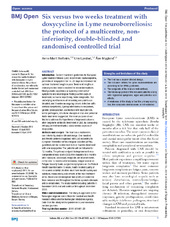| dc.contributor.author | Solheim, Anne Marit | en_US |
| dc.contributor.author | Ljøstad, Unn | en_US |
| dc.contributor.author | Mygland, Åse | en_US |
| dc.date.accessioned | 2020-03-13T08:33:36Z | |
| dc.date.available | 2020-03-13T08:33:36Z | |
| dc.date.issued | 2019 | |
| dc.Published | Solheim AM, Ljøstad U, Mygland Å. Six versus two weeks treatment with doxycycline in Lyme neuroborreliosis: the protocol of a multicentre, non-inferiority, double-blinded and randomised controlled trial. BMJ Open. 2019;9:e027083 | eng |
| dc.identifier.issn | 2044-6055 | |
| dc.identifier.uri | https://hdl.handle.net/1956/21481 | |
| dc.description.abstract | Introduction: Current treatment guidelines for European Lyme neuroborreliosis (LNB) recommend cephalosporins, penicillin or doxycycline for 14–28 days but evidence for optimal treatment length is poor. Treatment lengths in clinical practice tend to exceed the recommendations. Most patients experience a rapid improvement of symptoms and neurological findings within days of treatment, but some report long-term complaints. The underlying mechanisms of remaining complaints are debated, and theories as ongoing chronic infection with Borrelia burgdorferi, dysregulated immune responses, genetic predisposition, coinfection with multiple tick-borne pathogens, structural changes in CNS and personal traits have been suggested. The main purpose of our trial is to address the hypothesis of improved outcome after long-term antibiotic treatment of LNB, by comparing efficacy of treatment with 2 and 6 weeks courses of doxycycline. Methods and analysis: The trial has a multicentre, non-inferiority, double-blinded design. One hundred and twenty patients diagnosed with LNB according to European Federation of Neurological Societies (EFNS)guidelines will be randomised to 6 or 2 weeks treatment with oral doxycycline. The patients will be followed for 12 months. The primary endpoint is improvement on a composite clinical score (CCS) from baseline to 6 months after inclusion. Secondary endpoints are improvements in the CCS 12 months after inclusion, fatigue scored on Fatigue Severity Scale, subjective symptoms on the Patient Health Questionnaire-15 scale, health-related quality of life scored on RAND 36-item short form health survey and safety as measured by side effects of the two treatment arms. Blood and cerebrospinal fluid (CSF) are collected from inclusion and throughout the follow-up and a biobank will be established. The study started including patients in November 2015 and will continue throughout December 2019. Ethics and dissemination: The study is approved by the Norwegian regional committees for medical and health research ethics and the Norwegian Medicines Agency. Data from the study will be published in peer-reviewed medical journals. | en_US |
| dc.language.iso | eng | eng |
| dc.publisher | BMJ | eng |
| dc.rights | Attribution CC BY-NC | eng |
| dc.rights.uri | http://creativecommons.org/licenses/by-nc/4.0 | eng |
| dc.title | Six versus two weeks treatment with doxycycline in Lyme neuroborreliosis: the protocol of a multicentre, non-inferiority, double-blinded and randomised controlled trial | en_US |
| dc.type | Peer reviewed | |
| dc.type | Journal article | |
| dc.date.updated | 2019-12-13T11:59:42Z | |
| dc.description.version | publishedVersion | en_US |
| dc.rights.holder | Copyright 2019 The Author(s) | |
| dc.identifier.doi | https://doi.org/10.1136/bmjopen-2018-027083 | |
| dc.identifier.cristin | 1713209 | |
| dc.source.journal | BMJ Open | |

